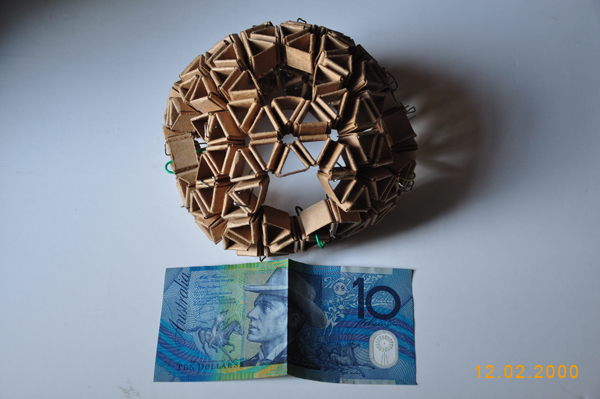TetraBox Lamp

Packet drinks are one of the most favored soft drinks among Malaysians. We just love sipping packet drinks wherever we go and never actually bother about the thousands of boxes we discarded off after each quench, despite knowing the fact that landfills across our country are bursting at the seams.
Perhaps, it’s about time we adopt a paradigm shift in our attitudes towards making this world a better place. As for me, here’s a little GREEN step I am taking to help reducing the amount of waste going to landfills.
Introducing TetraBox Lamp. You will never look at empty packet drinks the same way again!
This recycled lamp is made up of empty Tetra Brik boxes which are cut into strips.The strips are then folded to form hexagon and pentagon modules. No glue or any kind of adhesive is required to hold the modules together, a technique inspired by Kusudama origami.

The folding process is repeated with both modules being folded together to form a sphere.
A basic knowledge of geodesic dome construction ( Buckminster Fuller’s geodesic principle – see my first prototype below ) is definitely helpful. Practically, with sufficient packet drinks, one could even build a spherical pavilion as big as a house or a moon!
(Note: The hexagon modules can be easily structured to create many lamp design variations as shown below)

TetraBox Spherical Lamp.
Lamp Size: 260mm diameter.
Material: Discarded packet drinks boxes.
Boxes Required: Approximately 450 empty boxes.

Number of Hexagons required: 108 pieces
To make a Hexagon: 6 strips of 6 squares for the triangle (Size of strip – 130mm(L) x 21mm (W) ) and 6 strips of 4 squares for the knot (Size of strip – 76mm(L) x 19mm (W) to knot them together.
Number of Pentagons required: 12 pieces
To make a Pentagon: 5 strips of squares (Size of strip – 115mm (L) x 21 mm (W) and 5 strips of 4 squares for the knot ( Size of strip – 76mm (L) x 15mm (W) to knot them together.
Spherical Pavilion
Imagine if each of us were to turn the empty boxes after each quench into a hexagon, and collectively knot them together, what possibly could we achieve? We could possibly achieve building a spherical pavilion as big as a house!
Wouldn’t it be an idea worth pursuing further?
First Prototype
My first attempt to build a geodesic dome while I was studying at Deakin University.

TetraBox Lamp is the winner of the 2011 Bright Ideas Lighting Design Competition!
We guess hard work really does pay off because all those nights that designer Edward Chew spent cutting box drink cartons into hundreds of strips and folding them into pieces to create his beguiling Tetra Pak lamp have landed him the grand prize in the Bright Ideas Lighting Competition! Not only is the Tetra Pak Lamp absolutely breathtaking to behold, it’s also a fabulously creative example of upcycled design and craftsmanship – it was even assembled without the use of any adhesives!
“Ed Chew’s Tetra Pak lamp was a clear standout in the Bright Ideas Lighting Design Competition for its inspired use of materials and amazing craftsmanship; the designer painstakingly cut, folded and assembled hundreds of Tetrapak containers into this flawlessly geometric lamp. This is a shining example of upcycled design that is so professional and well-executed that you can’t tell it is made out of junk – but once you realize this, the story becomes even more impressive.” – Jill Fehrenbacher, Editor-in-Chief, Inhabitat.com

These stunning lamps designed by Edward Chew are made from recycled Tetra Pak cartons which were cut into strips, folded into hundreds of pieces, and then assembled without the use of any adhesives. The designer was able to create a variety of different lamp styles using the same origami module, and says that individuals can use it to create their own lamps. This design is a fantastic example of how a waste product can be re-purposed into a highly functional, and tasteful piece of furniture.
Ed Chew, Malaysia

PROFILE
Ed Chew is an architect currently dividing his time between practice and teaching. He teaches both architecture and urban design at Taylor’s University, continually seeking to merge the two bodies of knowledge. His interest focuses on exploring ways in which the principles of “making architecture” can be emplaced into the practice of placemaking.
His main area of interest is in the principles of community place-making; exploring the nature and meaning of place. His other areas of interest are: Tectonic Thinking – Where Making is Part of Thinking; Role of Educational Institutions as Catalysts for Urban Regeneration and Growth; Architecture of the Third Age – Creating Places for Active Third Age Communities; and Upcycled Architecture – The Art of Using (and Re-using) Recycled and Reclaimed Materials to Create Architectural Space.
In 2011, Ed Chew gained international recognition by winning the Grand Jury Prize in an international lighting competition organized by Inhabitat.com and Philips USA.
Main Research Source
- Grand prize winner - Ed Chew's Tetra Pak Lamp! - Inhabitat(17/06/2011)
- Edward Chew’s Tetra Pak Origami Lamps - Inhabitat
This design makes spectacular light patterns.








